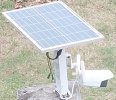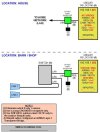I am not a noobie to CCTV. My NVR supporting up to 32 cameras currently supports 22 IP cameras. Some wired, some WiFi. Most are NETIP (H.265) and a few are only ONVIF. It's a combination of bullet, fisheye, and ptz units. I have one location that is giving me massive problems. It is overlooking my front gate.
Initially, I had no electric service there and so installed a solar solution, but could only get 20 hours each day before the batteries gave out. So, I eventually ran electric service to the location. Here is what is looks like.

Over the last four years, three "outside" weather resistant cameras have failed. Each runs well for a while -- months -- and then loses connection to the WiFi AP. The access point is about twenty unobstructed meters away from the camera location. My hand was a few inches from the AP as I took this photo from my office window,
In each case of the three, to attempt to fix it, 75-year-old me is getting on an extension ladder, resetting to factory settings and reconnecting to the camera to the AP. It works a couple of times but eventually each camera just dies completely. The current one died again last night after another of our typical heavy downpours; my location being no more than five kilometers from Sarangani Bay in the Philippines.
The camera is over looking a five meter steel gate, a smaller steel "manhole" door beyond it and a bit of the road at the entrance. Is there a camera that won't fail?
Initially, I had no electric service there and so installed a solar solution, but could only get 20 hours each day before the batteries gave out. So, I eventually ran electric service to the location. Here is what is looks like.

Over the last four years, three "outside" weather resistant cameras have failed. Each runs well for a while -- months -- and then loses connection to the WiFi AP. The access point is about twenty unobstructed meters away from the camera location. My hand was a few inches from the AP as I took this photo from my office window,
In each case of the three, to attempt to fix it, 75-year-old me is getting on an extension ladder, resetting to factory settings and reconnecting to the camera to the AP. It works a couple of times but eventually each camera just dies completely. The current one died again last night after another of our typical heavy downpours; my location being no more than five kilometers from Sarangani Bay in the Philippines.
The camera is over looking a five meter steel gate, a smaller steel "manhole" door beyond it and a bit of the road at the entrance. Is there a camera that won't fail?



